
We continue to study motherboards, large and small, rectangular and round, that is, square, with a combat kit or just with greetings from the manufacturer … But one thing unites them: they are based on the top chipset from Intel – Z690.
Of course, the chipset itself implies that where it stands, it is not cheap, and even the simplest motherboards can have price tags above 12,000 rubles (these are today’s realities of the IT market). At the same time, the form factor plays an important role, and the smaller the motherboard, the more expensive it is. It would seem… Why? Well, just because the presence of the Z690 obliges even “Lilliputian” motherboards to have a decent set of peripherals, and somehow it still needs to be placed on a tiny printed circuit board …
So, today we will study a tiny motherboard (Mini-ITX form factor), but stuffed with a bunch of everything, and therefore related to the premium Aorus segment from Gigabyte.
[pulling out a scroll with a declaimer..]… Let me remind you that we are studying boards here, not processors, and for them, in particular, the 12th generation from Intel has a special material .
The traditional table of differences in the chipsets of the last three generations.
| Peculiarities | Z690 | Z590 | Z490 |
|---|---|---|---|
| Compatible with Intel processors | 12th Gen Core | 10th & 11th Gen Core | 10th & 11th Gen Core |
| PCIe version (processor) | 4.0 & 5.0 | 3.0 (10th Gen) or 4.0 (11th Gen) | 3.0 (10th Gen) or 4.0 (11th Gen) |
| Number of PCIe lanes (processor) | 20 | 16 (10th Gen) or 20 (11th Gen) | sixteen |
| PCIe version (chipset) | 3.0 & 4.0 | 3.0 | 3.0 |
| Number of PCIe lanes (chipset) | 28 (12 x 4.0 & 16 x 3.0) | 24 | 24 |
| DMI Version | 4.0 | 3.0 | 3.0 |
| Number of DMI lines | x8 | x8 | x4 |
| RAM generation | DDR4 & DDR5 | DDR4 | DDR4 |
| Number of RAM channels | 2 | 2 | 2 |
| Maximum number of RAM slots | 4 | 4 | 4 |
| Maximum RAM | 128 GB | 128 GB | 128 GB |
| Number of SATA 6.0 Gb/s ports up to | eight | 6 | 6 |
| USB 3.2 Gen 2×2 ports (20Gbps) up to | 4 | 3 | 0 |
| USB 3.2 Gen 2×1 ports (10Gbps) up to | ten | ten | 6 |
| USB 3.2 Gen 1×1 ports (5Gbps) up to | ten | ten | ten |
| USB 2.0 ports up to | fourteen | fourteen | fourteen |
| Built-in Wi-Fi | WiFi 6E | WiFi 6 | WiFi 6 |
The Z690 supports PCIe 4.0 (12 out of 28 PCI-e lanes, the rest are 3.0). High-speed ports (High Speed In Out, HSIO) – 38. The Z690 also supports up to 4 integrated USB 3.2 Gen2x2 (up to 20 Gb / s) ports (although each of them requires support from two USB 3.2 Gen2, no matter from the Z690 itself or third party hubs). The 12th generation of processors adds another 20 PCIe lanes to this set, while 16 lanes (used for PCIe x16 slots) of the PCIe 5.0 version, the remaining 4 PCIe 4.0 lanes go to the M.2 slot. The same processors can now support DDR5 without abandoning DDR4, so motherboard manufacturers are free to release products with both DDR5 and DDR4 slots. Well, remember about the new LGA 1700 processor socket, so there is no more mutual compatibility with processors of the 11th and 10th generations.
The Gigabyte product we are reviewing today belongs to the gaming series and is part of the Aorus sub-brand (the family of which produces the most advanced, and, of course, expensive products from Gigabyte). At the same time, this motherboard inside Aorus, despite the smaller variety of peripherals relative to the top sisters under the same brand, is not at all a budget one: the Mini-ITX form factor imposes pricing obligations. Therefore, it is relatively average budget. However, given that now top motherboards can cost 70 thousand rubles or more, the price tag of 25 thousand rubles or more no longer seems fantastic.
Let’s start studying the Gigabyte Z690I Aorus Ultra motherboard .

The card comes in a standard Aorus branded hardboard box. On the front side, it is specially noted that this version of the motherboard is designed to work with DDR5 memory, because there is also a Z690I Aorus Ultra DDR4 version (both versions of the boards are completely identical in terms of the presence and location of peripherals).
The delivery set is located in the compartment under the board. In addition to traditional elements such as a user manual and SATA cables, there are: an antenna for the built-in Wi-Fi / BT module, screws for M.2 slots, adapters for USB 2.0 ports and case fans, a backlight extension, a sticker.
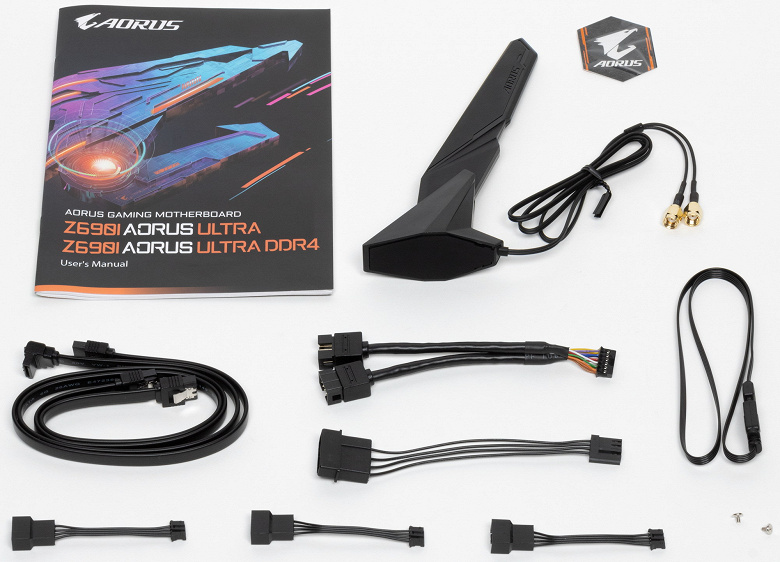
The software is not supplied with the board, but in any case it should be updated from the company’s website.
The “plug” for the rear panel with connectors is already mounted on the board itself.
Form factor
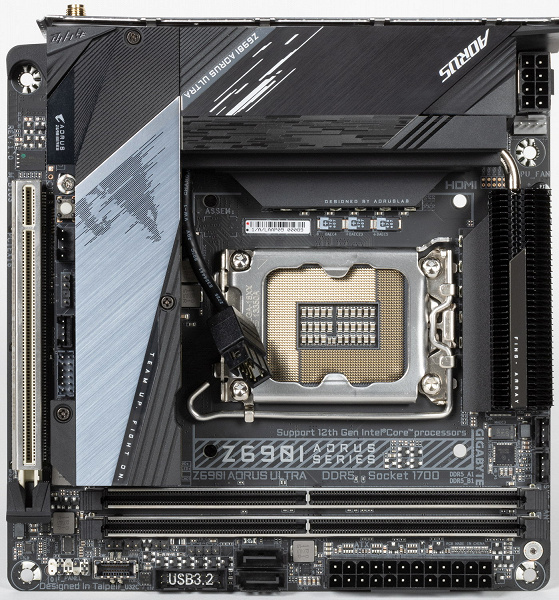
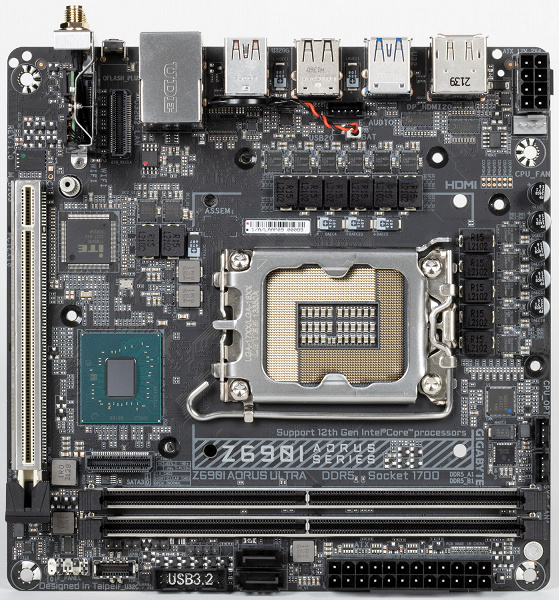
Motherboard Gigabyte Z690I Aorus Ultra has dimensions of 170×170 mm, made in the form factor Mini-ITX, and it has 4 mounting holes for installation in the case.


On the reverse side there are a number of controllers and hubs, other small logic. The textolite is processed very well: at all soldering points, not only the sharp ends are cut off, but everything is smoothly polished. On the same side, a nano-coated aluminum plate is installed. Also, the plate helps to remove heat from the back of the PCB through the thermal interface and provides rigidity to the motherboard.
Specifications

Traditional table with a list of functional features.
| Supported processors | 12th gen Intel Core |
|---|---|
| Processor socket | LGA 1700 |
| Chipset | Intel Z690 |
| Memory | 2 × DDR5 up to 6200 MHz (XMP), up to 64 GB, two channels |
| Audio subsystem | 1×2×1 Realtek ALC4080 |
| Network controllers | 1 × Intel I225-V Ethernet 2.5Gbps 1 × Intel Dual Band Wireless AX201NGW (Wi-Fi 802.11a/b/g/n/ac/ax (2.4/5 GHz) + Bluetooth 5.2) |
| Expansion slots | 1 x PCIe 5.0 x16 (x16 mode) |
| Drive Connectors | 2 x SATA 6Gb/s (Z690) 1 × M.2 (CPU, PCIe 4.0 x4 for 2260/2280 devices) 1 × M.2 (Z690, PCIe 4.0 x4 for 2260/2280 devices) |
| USB ports | 4 × USB 2.0: 2 x 4 ports internal (GL850) 2 × USB 2.0: 2 Type-A ports (black) (GL850) 2 × USB 3.2 Gen1: 1 x 2 ports internal header (Z690) 2 × USB 3.2 Gen1: 2 Type-A ports (blue) (Z690) 1 × USB 3.2 Gen2: 1 internal Type-C (Z690) 3 × USB 3.2 Gen2: 3 Type-A ports (red) (Z690) 1 × USB 3.2 Gen2x2: 1 Type-C port (Z690+IT8851) |
| Connectors on the rear panel | 1 × USB 3.2 Gen2x2 (Type-C) 3 × USB 3.2 Gen2 (Type-A) 2 × USB 2.0 (Type-A) 1 x RJ-45 2 audio mini jacks 2 antenna connectors 1 HDMI 2.0b 1 Display Port 1.4 |
| Other internal elements | 24-pin ATX power connector 1 8-pin EPS12V power connector 1 4-pin power connector for Gigabyte Thermal Guard III 1 M.2 slot (E-key), occupied by wireless network adapter 1 x USB 3.2 Gen2 Type-C connector 1 connector for connecting 2 USB 3.2 Gen1 ports 2 connectors for connecting 4 USB 2.0 ports 4 connectors for connecting 4-pin fans and water pumps 1 backlight connector (1 non-addressable RGB tape and 1 addressable ARGB tape) 1 connector for connecting the control adapter from the front panel of the case 1 BIOS Q Flash Plus button 1 start button 1 reset button |
| Form factor | Mini-ITX (170x170mm) |
| average price | at the time of preparation of the review, it is expected in the region of 24-25 thousand rubles |

Main functionality: chipset, processor, memory


Schematic diagram of the chipset + processor bundle.
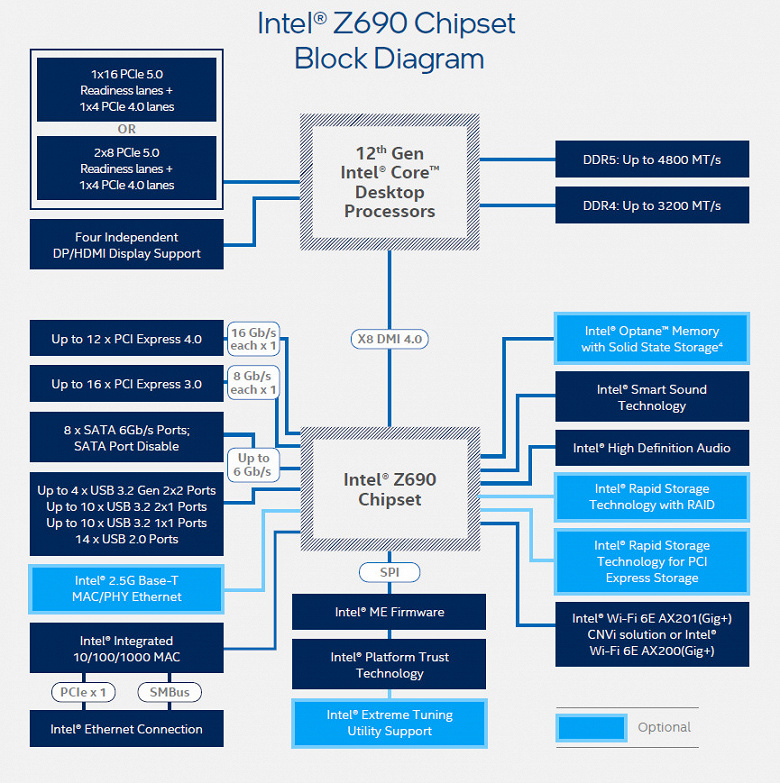
Formally, there is support for DDR5 memory up to 4800 MHz, but everyone is well aware, and motherboard manufacturers actively advertise this: through XMP profiles, you can now use frequencies up to 5333 MHz and higher. In particular, this board supports frequencies up to 6200 MHz.
12th generation Intel Core processors (compatible with socket LGA1700 and supported by Z690) have 20 I/O lanes (16 PCIe 5.0, 4 PCIe 4.0), do not have USB and SATA ports. At the same time, interaction with the Z690 goes through a special Digital Media Interface 4.0 (DMI 4.0 x8) channel. All PCIe lanes of the processor go to PCIe expansion slots and an M.2 port. Serial Peripheral Interface (SPI) is used to communicate with the UEFI / BIOS system, and the Low Pin Count (LPC) bus is used to communicate with I / O devices that do not require high bandwidth (fan controllers, TPM, old peripherals).
In turn, the Z690 chipset supports a total of 38 I / O lines, which can be distributed as follows:
- up to 14 USB ports (of which up to 4 USB 3.2 Gen2x2 ports, 10 USB 3.2 Gen2 ports, up to 10 USB 3.2 Gen1 ports, up to 14 USB 2.0 ports, USB 2.0 lines are also used to support 3.2 ports, and each USB port 3.2 Gen2x2 requires support from two USB 3.2 Gen2);
- up to 8 SATA 6Gb/s ports;
- up to 28 PCIe lanes (16 version 3.0 and 12 version 4.0).

Once again, it must be recalled that the Gigabyte Z690I Aorus Ultra supports 12th generation Intel Core processors made for the LGA1700 socket (socket). The mounting system for CPU cooling systems is not compatible with the one for LGA1151/1200. But at the same time, it should be borne in mind that a number of old COs can still be used, you just have to buy somewhere or order a mounting kit for LGA 1700 from the manufacturer. The fact is that the new 12xxx processors are 0.8 mm thinner than their predecessors , and coolers with a fixed-height hard-mounted motherboard may simply not reach 12xxx. Only CO with a springy landing of the sole on the processor will do.

There are two DIMM slots for installing memory modules on the Gigabyte board. The board supports unbuffered DDR5 (non-ECC) memory, and the maximum memory capacity is 64 GB. Of course, XMP profiles are supported.
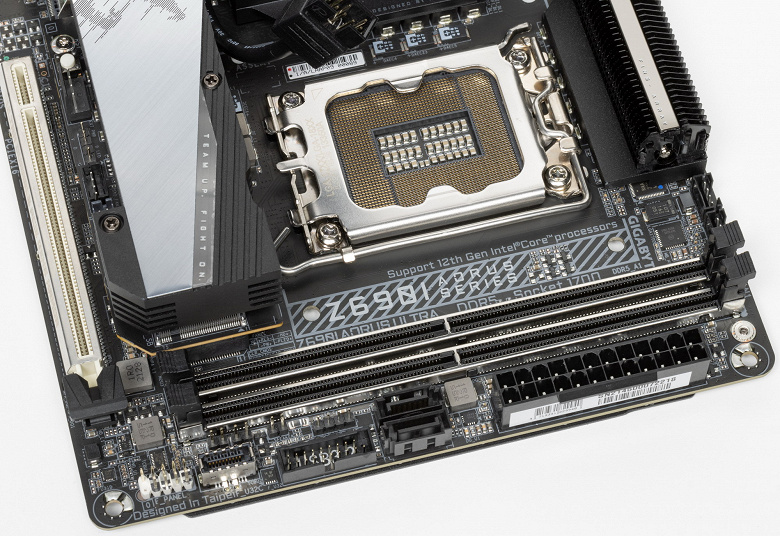
DIMM slots have metal edging to protect them from both physical damage and interference.
Peripheral functionality: PCIe, SATA, various “baubles”
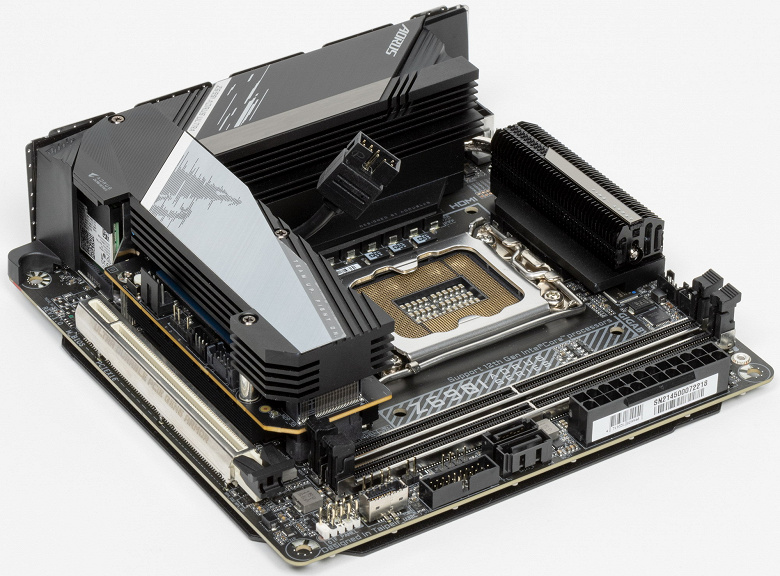
Above, we studied the potential capabilities of the Z690 + Core tandem, and now let’s see what of this and how it is implemented in this motherboard.

Note: the diagram is common for the current version of the board (elements specific to this model are marked (1) and for Z690I Aorus Ultra DDR4 (elements specific to this model are marked (2).
In addition to the USB ports, which we’ll get to later, the Z690 chipset has 28 PCIe lanes. We consider how many lines are spent on support (communication) with one or another element (it should be borne in mind that 28 lines are not a single version, but 12 PCIe 4.0 lines and 16 PCIe 3.0 lines):
- SATA_0/1 ports: 2 PCIe 3.0 lanes;
- M2P_SB slot ( 4 lanes PCIe 4.0);
- Intel i225-V (Ethernet 2.5Gb/s) ( 1 lane PCIe 3.0);
- Intel AX200NGW WIFI/BT (Wireless) ( 1 lane PCIe 3.0)
A total of 8 PCIe lanes were occupied (4 PCIe 4.0 + 4 PCIe 3.0). The Z690 chipset communicates with audio codecs via a USB port. Also, one USB 2.0 is spent on BT support (if there is an M.2 slot (key E) and the IT8851 and GL850 controllers use USB 2.0 signal lines for their needs. More details about this below in the USB ports section.
Now let’s look at how the processors work in this configuration above. The 12th generation CPU has a total of 20 PCIe lanes, 4 of which are allocated to the M.2 port (M2A_CPU) of the PCIe 4.0 version. The remaining 16 PCIe 5.0 lanes go to the PCIe x16_1 slot. He is alone, so there are no divisions of resources here.
The PCIe x16_1 slot has a stainless steel Ultra Durable PCIe Gen5 armor that increases durability (which can be important in case of fairly frequent graphics card changes, but more importantly: such a slot can more easily withstand bending loads in case of installing a very heavy graphics card top-level protection.In addition, this protection protects the slots from electromagnetic interference.

Given the very compact dimensions of the motherboard and at the same time high VRM heatsinks, it is obvious that any CO will fit far here (well, except for the CBO pumps).
Next up are storage.
In total, the board has 2 Serial ATA 6 Gb / s + 2 slots for drives in the M.2 form factor. The SATA ports are implemented through the Z690 chipset and support RAID creation.
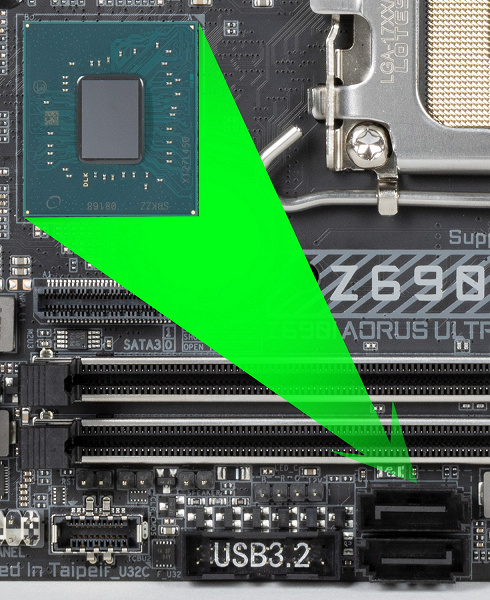
The motherboard has 2 M.2 form factor sockets.


To place these slots on such a compact board, the developers used a proprietary invention called M.2 Thermal Guard III – a kind of “sandwich”: on top there is one M2A_CPU slot connected directly to the CPU, and on the bottom – M2P_SB connected to the Z690.
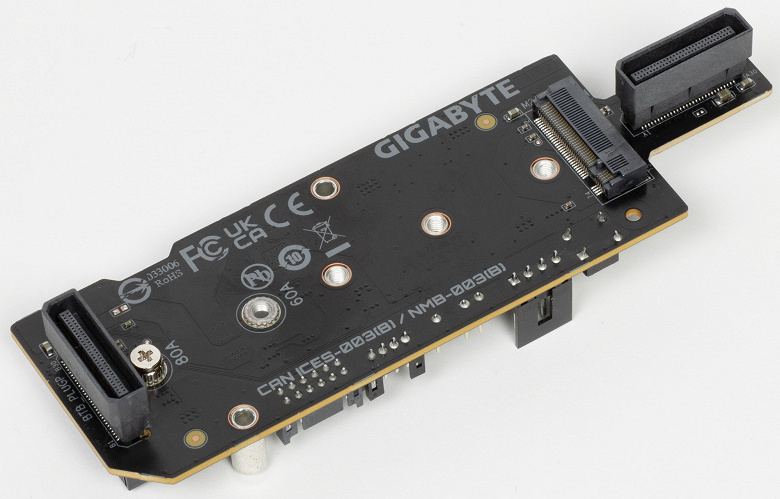

Both slots work with PCIe- only modules and support 2260/2280 module sizes. And M2A_CPU is also 2242. On both M.2, you can organize RAID, and also use it for Intel Optane Memory.
It should be especially noted that the Thermal Guard III board (also called GC-Z690I BTB Plug) has a power connector (the adapter requires a “tail” from a Molex PSU), otherwise there may not be enough power for both M.2 drives at the same time.
As you can clearly see from the photos, both M.2 slots have heatsinks. The top M2A_CPU has the most powerful and thickest heatsink.
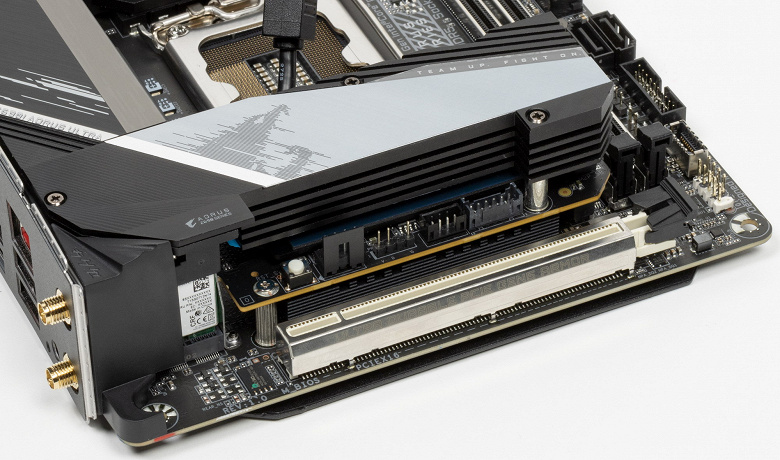
Other features (“baubles”) on the board
Now about the “baubles”, that is, “bells and whistles”. There are few of them on this board (after all, the “Lilliputian” motherboard is unable to accommodate all kinds of additional features inherent in the top Aorus series). For example, there is no power button.
A reset button (and even a jumper for closing contacts) are available. It should be noted that in addition to the Reset jumpers available in the front panel block, a separate Reset jumper is programmed in the BIOS and can be assigned other functions.
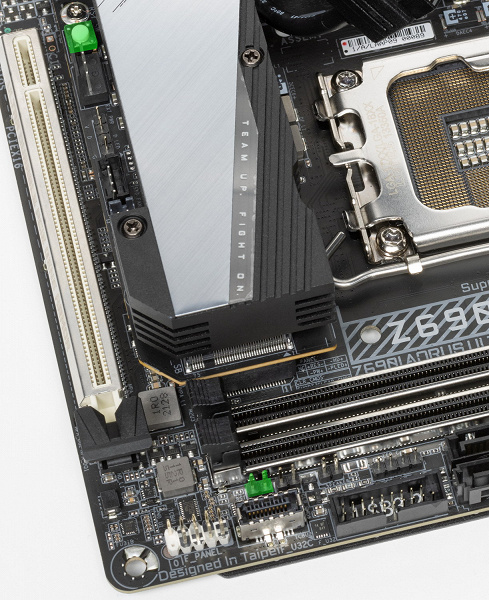
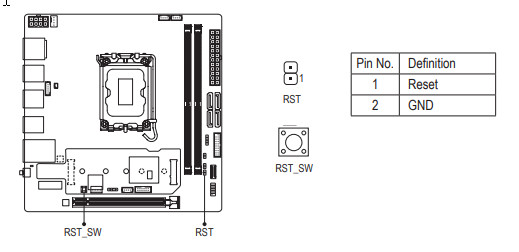
There are no any kind of buttons and jumpers that help overclockers. But there is a jumper responsible for resetting the CMOS settings in the BIOS.
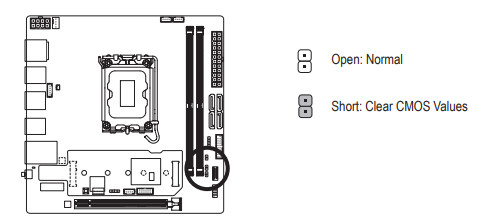
It is worth mentioning the ability of the motherboard to connect RGB lighting. There are 2 connectors for connecting any devices of this plan: 1 connector for connecting addressable (5 V 3 A, up to 15 W) ARGB tapes / devices (it is located on the Thermal Guard III board), and 1 connector for non-addressable (12 V 3 A, up to 36 W) RGB tapes/devices (located on the main PCB).
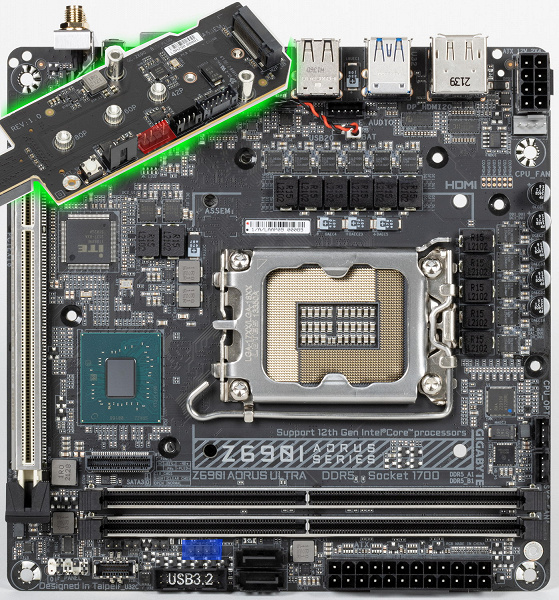
Connection diagrams are standard for all motherboards that support backlighting:
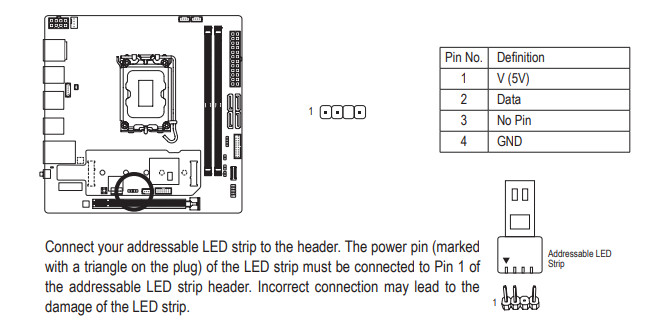

Of course, there is also a traditional set of FPanel pins for connecting wires to the front (and now often the top or side or all of this at once) panel of the case.
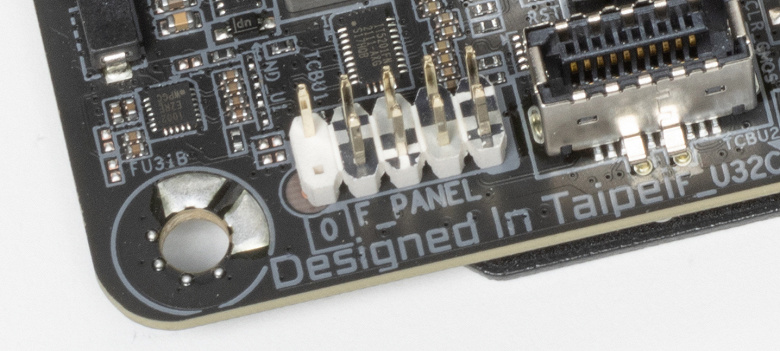
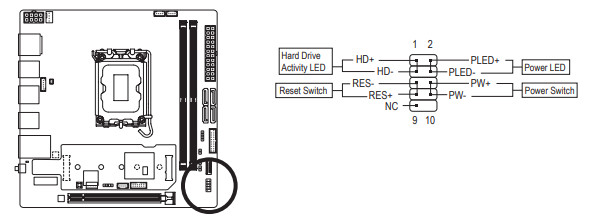
The MXIC MX25L25673GZ chip from Macronis is used to host the UEFI/BIOS firmware.

Like many high-end motherboards, this board has the technology of “cold” BIOS flashing without turning on the board itself (the presence of RAM, a processor and other peripherals is optional, you just need to connect the power) – Q Flash Plus.
For such a BIOS update, the firmware version must first be renamed to GIGABYTE.bin and written to the root of a USB flash drive, which is inserted into the specially marked USB port.
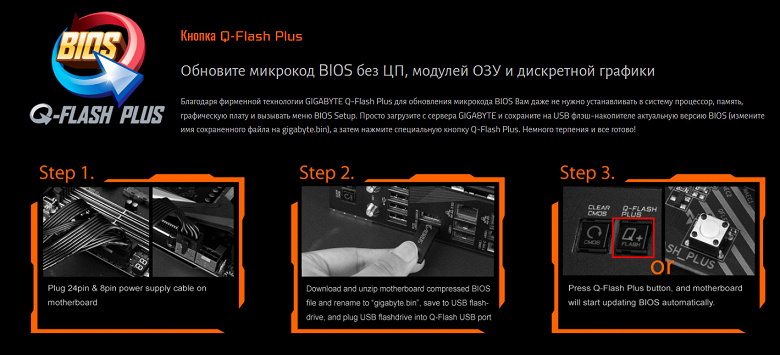
Well, start through the button (it is on the back panel), which must be held for 3 seconds. The controller from ITE is in charge of this technology.
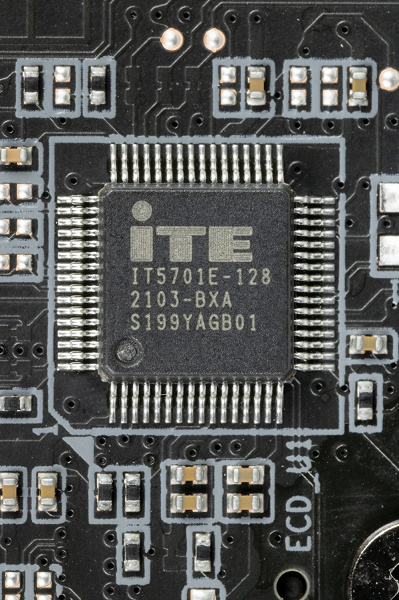
Peripheral functionality: USB ports, network interfaces, I/O
Now it’s the turn of USB ports and other I/O. And let’s start with the back panel, where most of them are displayed.

To reiterate, the Z690 chipset is capable of implementing a maximum of 14 USB ports, of which there can be up to 10 USB 3.2 Gen1 ports, up to 10 USB 3.2 Gen2 ports, up to 4 USB 3.2 Gen2x2 ports, and/or up to 14 USB 2.0 ports.
We also remember about 28 PCIe lines, which go to support drives, network and other controllers (I have already shown above what and how 8 out of 28 lines are spent).
And what do we have? There are a total of 15 USB ports on the motherboard:
Thus, we have 5 controllers using USB lines:
- ITE IT8851 (USB 3.2 Gen2 for Gen2x2) ( 1 x USB 2.0 line );
- Genesys Logic GL850G (4 USB 2.0 Type-A) ( 1 USB 2.0 line );
- Genesys Logic GL850G (4 USB 2.0 internal) ( 1 USB 2.0 line );
- Audio ( 1 line USB 2.0);
- Bluetooth (AX201) ( 1 line USB 2.0).
So, high-speed USB ports are implemented through the Z690 chipset:
- 1 dedicated USB 3.2 Gen2x2 (does not count, because it was received at the expense of other HSIOs);
- + 4 dedicated USB 3.2 Gen2
- + 4 dedicated USB 3.2 Gen1
- + 1 USB 3.2 Gen2 to support USB 3.2 Gen2x2
= 9 high-speed ports . Do not forget that each high-speed USB port is provided with a USB 2.0 port, that is, already 9 USB 2.0 ports are also occupied. Plus 5 USB 2.0 ports to provide controllers. A total of 14 USB ports are implemented .
Well, 8 PCIe lanes allocated to support other peripherals.
In total, the Z690 in this case has 17 high-speed ports out of 38 .
All fast USB Type-C ports are equipped with re-drivers from Diodes Inc, which provide a stable voltage that can provide fast charging of mobile gadgets through them.


Now about network affairs.

The motherboard is equipped with good communication facilities. There is a high-speed Intel I225-V Ethernet controller capable of operating according to the 2.5 Gb / s standard.
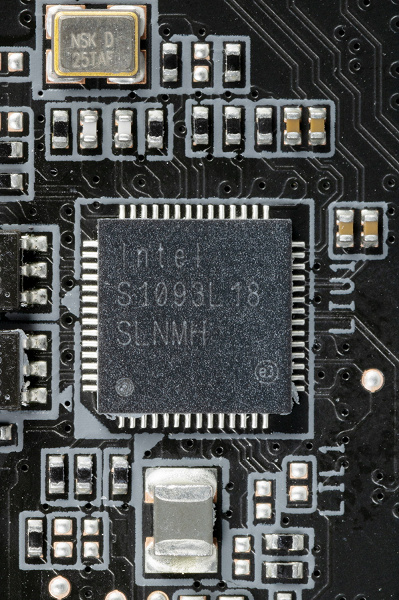
There is also an integrated wireless adapter on the Intel AX-201NGW controller (Killer 1650i adapter itself manufactured by Rivet Networks), through which Wi-Fi 6E (802.11a/b/g/n/ac/ax) and Bluetooth 5.2 are implemented. It is installed in the M.2 (E-key) slot, and its connectors for screwing remote antennas are brought out to the rear panel.

The plug, traditionally put on the rear panel, is already put on in this case, and is shielded from the inside to reduce electromagnetic interference.

I/O block, fans, etc.
Now about the I / O block, connectors for connecting fans, etc. There are 4 connectors for connecting fans and pumps on the board itself. The layout of connectors for cooling systems looks like this:

Three of the four sockets are proprietary (one socket is on the Thermal Guard III), the fans are connected via the supplied adapters – extension cords, only the CPU cooler socket is standard. Through the software or BIOS (Smart Fan6) all sockets for connecting air fans or pumps are controlled: they can be controlled both through PWM and by a banal change in voltage / current.
The ITE IT8689E controller is responsible for monitoring the state of the board and controlling the operation of all CO slots (as well as the entire Milti I/O).
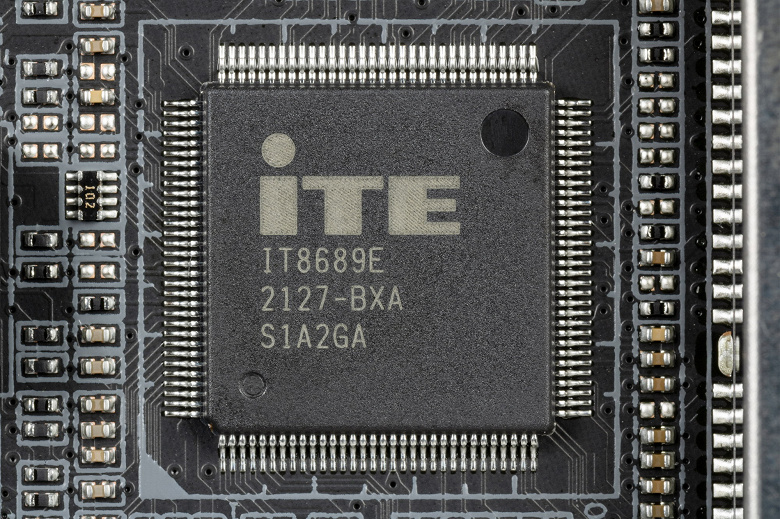
Considering that Intel processors can have integrated graphics, the board has two graphics output slots: Display Port 1.4. and HDMI 2.0b.
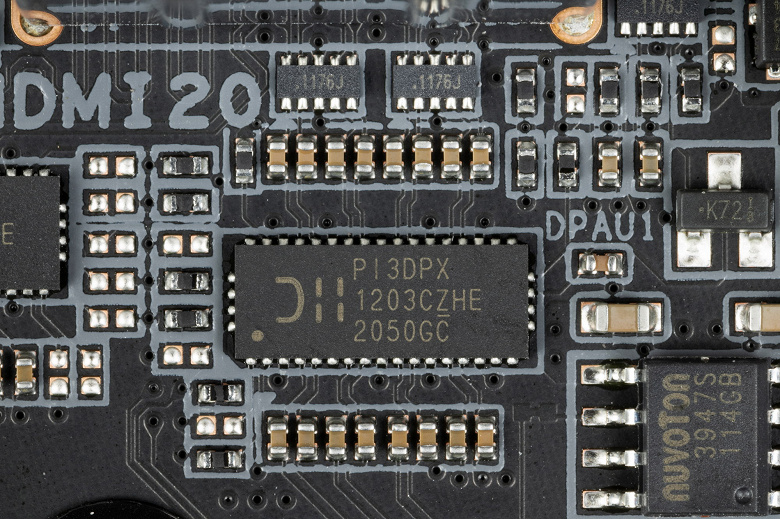

Signal amplifiers (redrivers) from Diodes Inc. were used to provide DP 1.4 and HDMI 2.0b versions.
Audio subsystem
We know that the most popular audio codec in most modern motherboards is a product from Realtek. In this case, it’s the ALC4080, which provides up to 7.1 audio output at up to 32-bit/384kHz resolution.

We also note that the current motherboard has a greatly simplified audio output to stereo output, and even no S/PDIF for 7.1 output. So the card has two universal connectors for receiving and outputting signals. The entire audio path is located on a separate mini-board, which is fixed under the cover of the rear port panel.

Neither DAC nor operational amplifiers are provided in this path. Audiophile capacitors are used in the board’s audio circuits. The nests have markings, but they are written very indistinctly.

Audio path test results in RMAA
To test the output sound path intended for connecting headphones or external acoustics, we used an external Creative E-MU 0202 USB sound card in combination with the RightMark Audio Analyzer 6.4.5 utility. Testing was conducted for stereo mode, 24-bit/44.1 kHz. During testing, the test PC’s UPS was physically disconnected from the mains and running on battery.
According to the test results, the audio path on the board was rated “Very good”.
| Device under test | Gigabyte Z690I Aorus Ultra |
|---|---|
| Working mode | 24-bit, 44 kHz |
| Sound interface | MME |
| Signal route | rear panel output – Creative E-MU 0202 USB input |
| RMAA version | 6.4.5 |
| Filter 20 Hz – 20 kHz | Yes |
| Signal normalization | Yes |
| Level change | -0.1dB /-0.1dB |
| Mono mode | No |
| Calibration signal frequency, Hz | 1000 |
| Polarity | correct/correct |
General results
| Frequency response unevenness (in the range of 40 Hz – 15 kHz), dB |
+0.11, +0.01 |
Fine |
| Noise level, dB (A) |
-82.0 |
Good |
| Dynamic range, dB (A) |
80.5 |
Good |
| Harmonic distortion, % |
0.00546 |
Very well |
| Harmonic distortion + noise, dB(A) |
-75.0 |
Medium |
| Intermodulation distortion + noise, % |
0.021 |
Good |
| Interpenetration of channels, dB |
-72.3 |
Good |
| Intermodulation at 10 kHz, % |
0.016 |
Very well |
| Overall rating |
Very well |
frequency response

|
Left |
Right |
|
| From 20 Hz to 20 kHz, dB |
-0.68, +0.02 |
-0.59, +0.11 |
| From 40 Hz to 15 kHz, dB |
-0.08, +0.02 |
+0.01, +0.11 |
Noise level

|
Left |
Right |
|
| RMS power, dB |
-82.2 |
-82.0 |
| Power RMS, dB(A) |
-82.0 |
-81.9 |
| Peak level, dB |
-63.5 |
-63.4 |
| DC offset, % |
-0.0 |
-0.0 |
Dynamic Range

|
Left |
Right |
|
| Dynamic range, dB |
+80.8 |
+80.7 |
| Dynamic range, dB (A) |
+80.5 |
+80.4 |
| DC offset, % |
-0.00 |
-0.00 |
Harmonic distortion + noise (-3 dB)
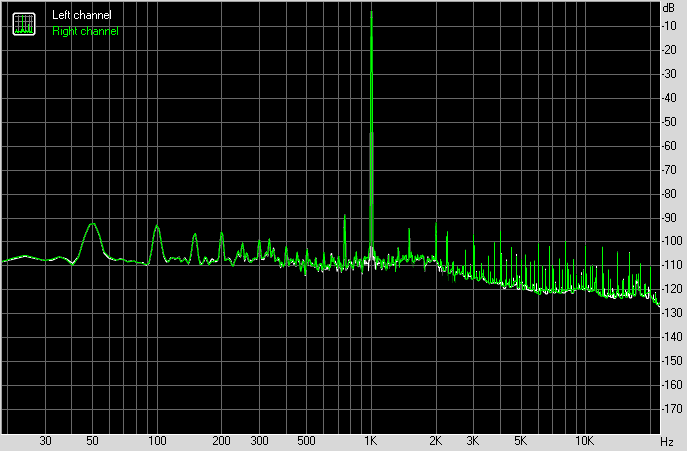
|
Left |
Right |
|
| Harmonic distortion, % |
0.00514 |
0.00577 |
| Harmonic distortion + noise, % |
0.01702 |
0.01780 |
| Harmonic Distortion + Noise (A-weighted), % |
0.01714 |
0.01823 |
Intermodulation distortion
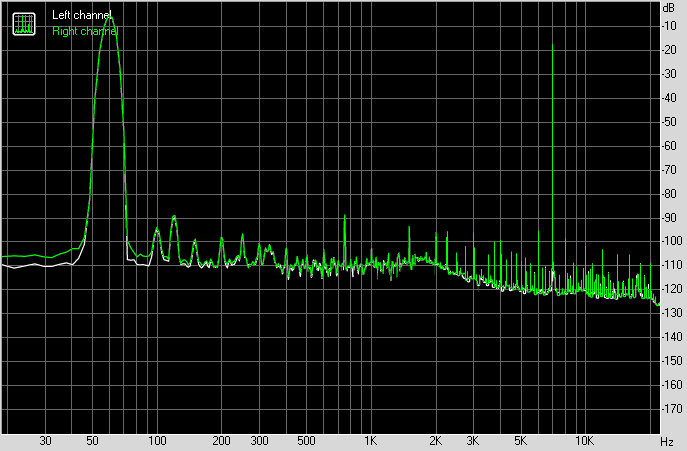
|
Left |
Right |
|
| Intermodulation distortion + noise, % |
0.02097 |
0.02176 |
| Intermodulation distortion + noise (A-weighted), % |
0.02074 |
0.02081 |
Interpenetration of stereo channels

|
Left |
Right |
|
| Penetration at 100 Hz, dB |
-72 |
-74 |
| Penetration at 1000 Hz, dB |
-71 |
-71 |
| Penetration at 10000 Hz, dB |
-72 |
-72 |
Intermodulation distortion (variable frequency)
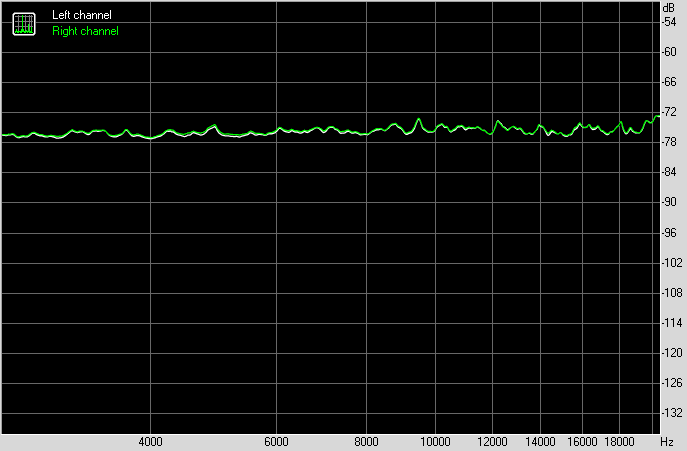
|
Left |
Right |
|
| Intermodulation distortion + noise at 5000 Hz, |
0.01556 |
0.01634 |
| Intermodulation distortion + noise at 10000 Hz, |
0.01730 |
0.01759 |
| Intermodulation distortion + noise at 15000 Hz, |
0.01532 |
0.01548 |
Power, cooling
There are 3 connectors for powering the board: in addition to the 24-pin ATX, there is another EPS12V (8-pin) and a special 4-pin connector on the Thermal Guard III to power that very additional “sandwich” board. The latter has the form of power for floppy drives, and the package includes an adapter for a 4-pin Molex.

The processor power circuit has a total of 13 phases, made according to the 10 + 1 + 2 scheme.
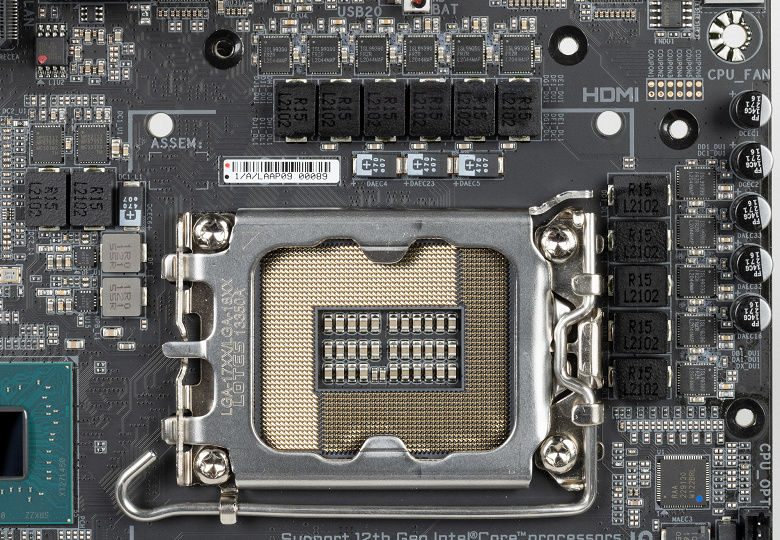

10 phases per processor core, 1 phase VCCGT (iGPU) – for integrated graphics in the processor and 2 phases for VCCIO (VCCAUX) – memory and I / O controller control unit.
Each phase channel for the VCore and iGPU has a super ferrite choke and a Renesas (-ex Intersil) ISL99390 90A MOSFET.
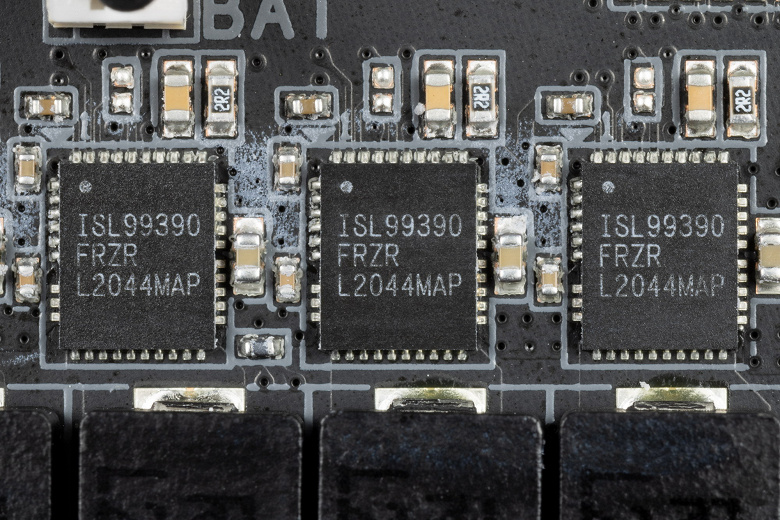
The VCore + iGPU circuit is controlled by the Renesas RAA229130 PWM controller, which is designed for 20 phases.
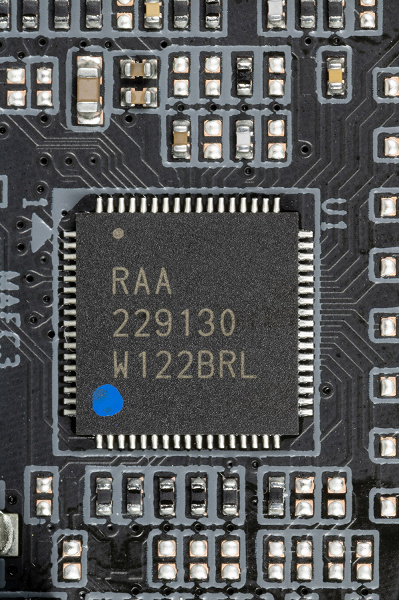
The VCCIO is powered by a two-phase circuit with mosfets (up to 70A) and a digital controller from Monolithic Power Systems.
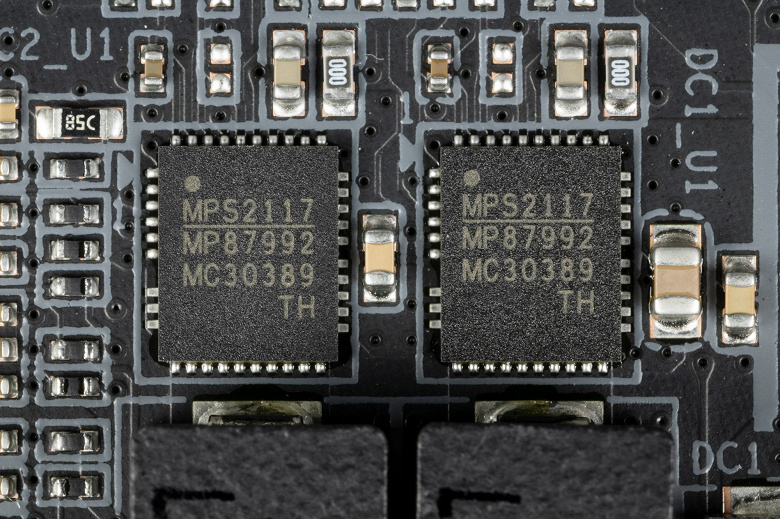
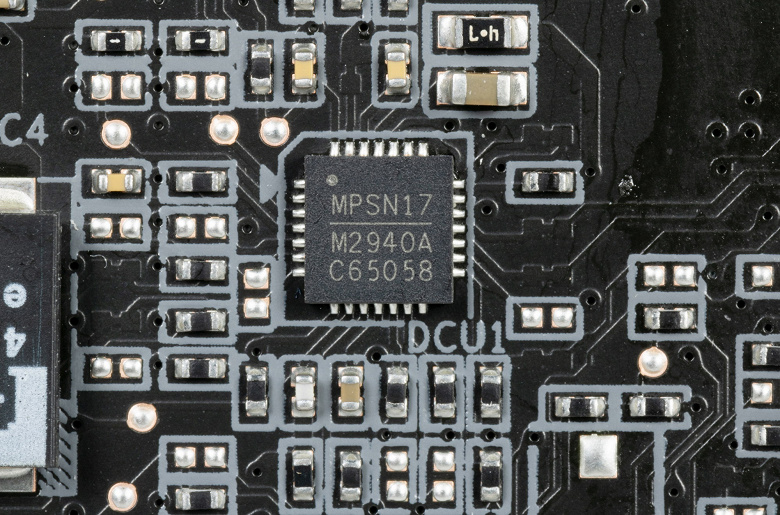
As for the RAM modules, a single-phase circuit with a power converter from On Semi is implemented here.
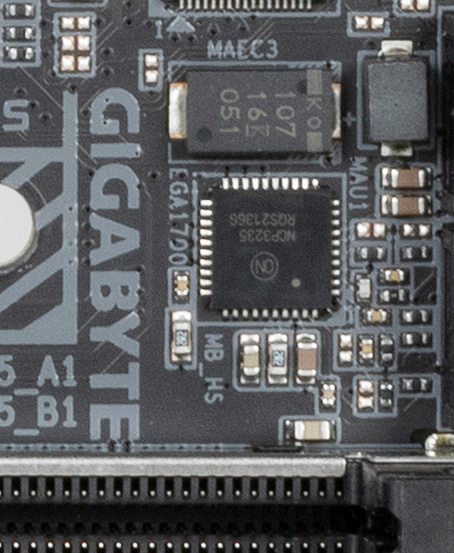
As usual, Aorus motherboards use Ultra Durable technology, which provides a double layer of copper in the power and ground circuits, which helps not only improve signal transmission (remove interference), but also more efficient heat dissipation. It also provides for the use of tantalum capacitors on the reverse side in place of the processor socket. In general, given the compactness of the printed circuit board, this motherboard has 10 layers.
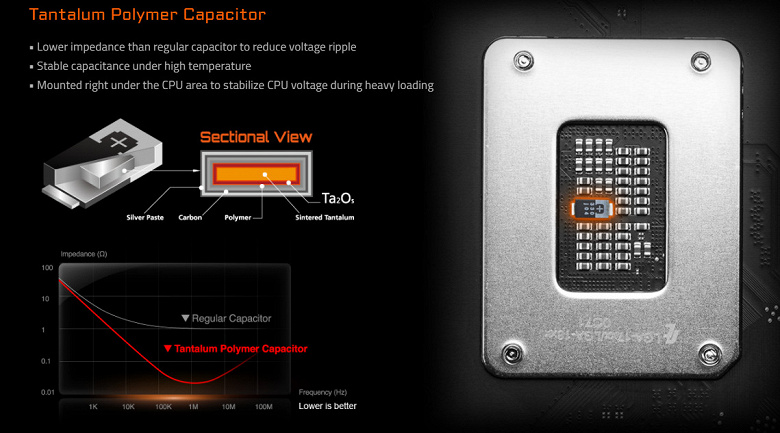
Now about cooling.
All potentially hot elements have their own heatsinks.

The VRM section has its own two heatsinks connected by a heat pipe. The highlight of this motherboard is the presence of Thermal Guard III, a kind of “sandwich” of a small board and heatsinks.

The lower M.2 slot has a heatsink in common with the Z690 system chipset, and the upper M.2 slot is equipped with a particularly thick heatsink (it is assumed that the fastest and most heated SSD drives will be installed in this slot).
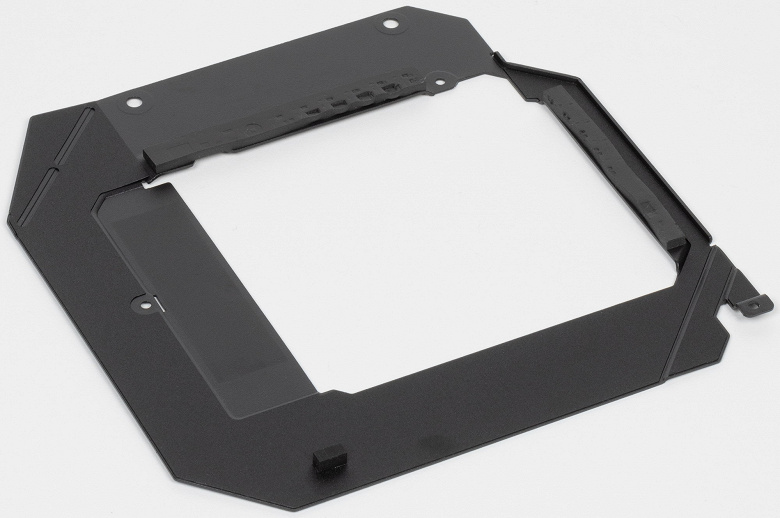
The motherboard has a backplate, a backplate that helps the PCB not only maintain rigidity, but also cool in the area of the VRM power converters.
Backlight
All about outer beauty
This motherboard has a modest backlight, with only a few LEDs located along the right edge on the reverse side.

Of course, this is not a problem, because now there are a lot of other backlight sources for PCs, and we also remember about 2 connectors for connecting external lighting, and all this can be controlled through the RGB Fusion program.
A number of manufacturers of modding cases with lighting already installed “certify” support for programs from leading motherboard manufacturers, including Gigabyte.
Software for Windows
Gigabyte Proprietary Software
All software can be downloaded from the manufacturer’s website gigabyte.com . The main program – so to speak, the manager of all “software” – is the App Center. It should be installed first. The App Center helps you download all the other necessary (and not quite necessary) utilities. Most of them run only from the App Center. The same program also monitors the updates of installed proprietary software from Gigabyte, as well as the relevance of the BIOS firmware.
The RGB Fusion 2.0 program can recognize all Gigabyte proprietary elements equipped with backlight, including memory modules.

In this case, the motherboard itself has a backlight, and also has 4 sockets for connecting it, and the utility also recognized the presence of a video card from Gigabyte.

Gigabyte has two main utilities for managing motherboard settings: EasyTune and SIV. Let me briefly say that the EasyTune utility is for those who are reluctant to get into the intricacies of overclocking: you can simply select a mode so that the system sets all the frequencies and voltages by itself. Another interesting utility is SIV. It allows you to control fans: we select modes based on noise characteristics. The modes are “smart”, that is, if you select, for example, the “quiet” mode, then the fan speed will be kept at a minimum level as long as it is possible due to the heating of the processor / board (we remember that the board is equipped with a mass of thermal sensors ), then a signal will be generated to reduce frequencies as part of Turbo Boost.
I have already written about all these programs many times before, I do not want to repeat them.
BIOS settings
What give us the subtleties of settings in the BIOS
All modern boards now have UEFI (Unified Extensible Firmware Interface), which, in fact, are operating systems in miniature. To enter the settings when the PC boots up, traditionally you need to press the Del or F2 key.

The general “simple” menu gives us essentially one information (with the choice of only some options), so we press F7 and we get to the “advanced” menu.



Advanced settings (Settings). In principle, a standard set of peripheral control positions, however, you can only generally turn on or off certain devices (or a group), but there is no way to configure the operation, for example, of each USB port.
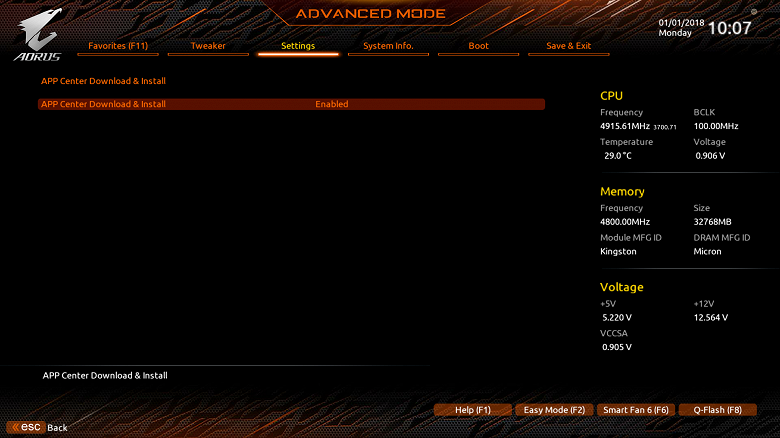

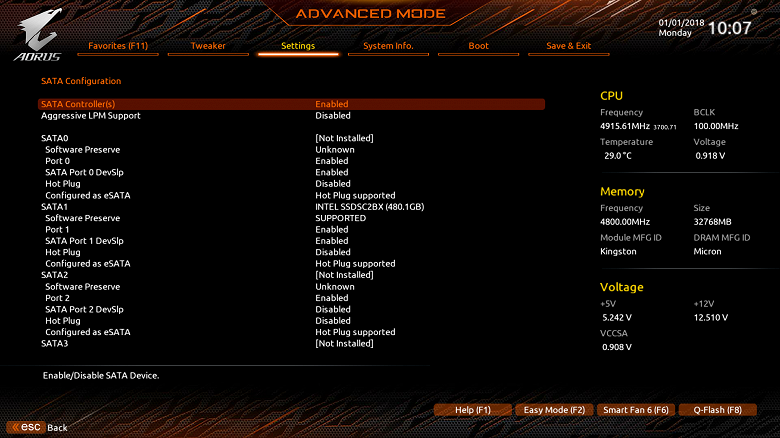
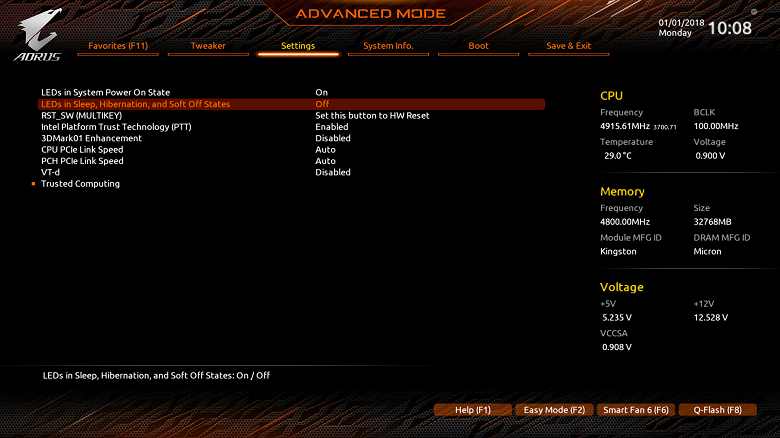
The boot menu is also usual and familiar, and the fan settings menu is very convenient.

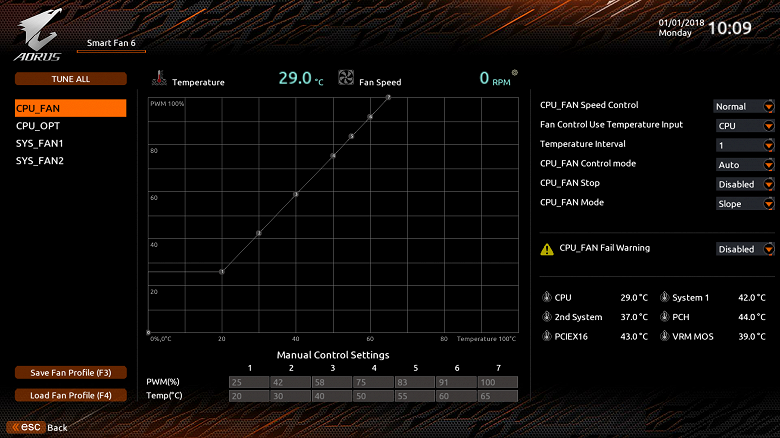
In terms of overclocking, the set of options is standard for the Aorus family (well, it’s clear that not as many as Xtreme, for example) and more than enough for any overclocker (besides, we all know that modern auto-overclocking, legalized by Intel and AMD themselves, makes useless many options).


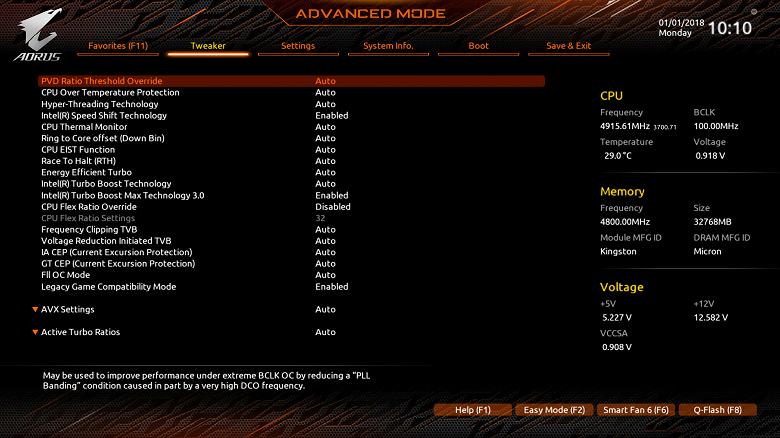
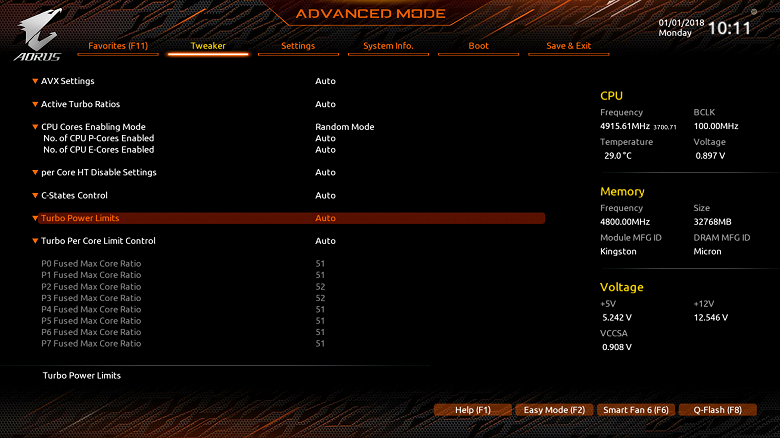
Performance (and overclocking)
Test system configuration
Full test system configuration :
- motherboard Gigabyte Z690I Aorus Ultra;
- processor Intel Core i9-12900K 3.4-5.2 GHz;
- RAM Kingstone Fury (KF552C40BBK2-32) 32 GB (2×16) DDR5 4800 MHz (XMP 5200 MHz) ;
- Gigabyte Aorus Gen4 SSD 500GB (GP-AG4500G) ;
- graphics card built into the i9-12900K;
- power supply Super Flower Leadex Platinum 2000W (2000 W);
- unattended ZhSO;
- TV LG 55Nano956 (55″ 8K HDR);
- USB – keyboard and mouse.
Software:
- operating system Windows 11 Pro, 64-bit
- AIDA 64 Extreme
- 3DMark Time Spy CPU benchmark
- 3DMark Fire Strike Physics benchmark
- 3DMark Night Raid CPU benchmark
- HWInfo64
- OCCT v.10.0.6
- Adobe Premiere CS 2019 ( video rendering)
For technical reasons, it was not possible to save test screenshots.
We start everything in default mode. Then we load with stress tests. As expected (and this is almost standard auto-overclocking), by default, the motherboard set the processor frequencies to 4.9 GHz for P-cores under a very heavy load. As for the E-cores, they are also not bad: 3.7 GHz under stress, and 3.9 GHz without it. The temperature of the VRM was a little high (about 75 degrees), the chipset heated up moderately: no higher than 60°C.
Given the size of the motherboard and its focus is clearly not on super-overclocking, I did not engage in manual overclocking, because auto overclocking is very good for such a little one.
findings
The Gigabyte Z690I Aorus Ultra motherboard is designed for gamers, like all products under the Aorus brand. But a model of such a compact size simply cannot implement all the flagship functionality, so this solution belongs more to the middle segment (at the time the review was published, the board was not yet sold in Russia).

The board has 15 USB ports of various types (including USB 3.2 Gen2 × 2, 4 USB 3.2 Gen2 and 4 USB 3.2 Gen1), 1 PCIe 5.0 x16 slot, 2 M.2 slots, 2 SATA ports. There are 4 connectors for connecting fans and pumps, all drives in M.2 slots are equipped with radiators. Network Connections – 2.5 Gigabit wired controller and wireless with Wi-Fi 6 and Bluetooth support. The backlight here is modest, but there are opportunities for connecting additional RGB devices.
In any case, the price of the board will not be low, like all solutions in the Mini-ITX format, but here a top-end chipset is also added. But even such a little one can squeeze almost the maximum out of the CPU, since there is an excellent power supply system here. So those who want to assemble a powerful modern PC in a compact size can pay attention to this model.
In the Original Design nomination, the Gigabyte Z690I Aorus Ultra received the following award:

We thank Gigabyte Russia
and personally Maria Ushakova
for the fee provided for testing
and also Evgenia Lesikova
for the provided Gigabyte Aorus Gen4 SSD 500G for the test bench
Special thanks to Super Flower
for providing Super Flower Leadex Platinum 2000W power supply




